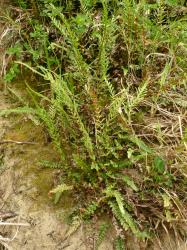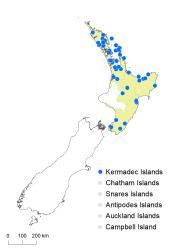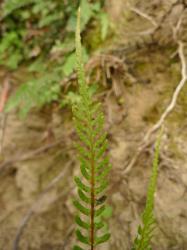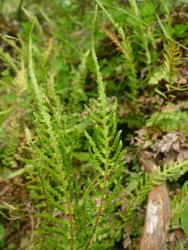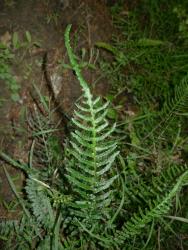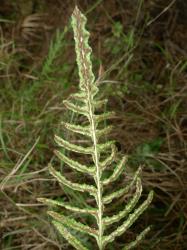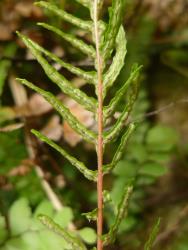- ≡ Doodia squarrosa Colenso, Trans. & Proc. New Zealand Inst. 13: 382 (1881)
- ≡ Doodia caudata var. squarrosa (Colenso) C.Chr., Index Filic. 242 (1905)
Rhizomes erect, up to 100 mm tall (in herbarium material), bearing scales. Rhizome scales narrowly ovate, 1.5–2.5 mm long, 0.4–0.7 mm wide, pale brown, concolorous. Fronds weakly dimorphic, sterile fronds 85–430 mm long, forming a prostrate rosette; fertile fronds on same plant usually a little longer, 110–530 mm long, positioned centrally, held erect. Sterile fronds. Stipes 25–140 mm long, black-brown proximally, becoming red- or yellow-brown distally, bearing pale brown narrowly ovate scales, lacking hairs. Rachises yellow-brown, grooved adaxially, bearing occasional scales, lacking hairs. Laminae 70–200 mm long, 15–50 mm wide, pinnatisect to 1-pinnate, narrowly elliptic to linear, tapering to a long pinnatifid apex, similar colour on both surfaces, usually tinged red when young, herbaceous, bearing occasional scales on costae, lacking hairs. Pinnae in 9–28 pairs, widely spaced, ovate to oblong, straight, reducing only slightly at the base of the lamina, sometimes lobed acroscopically; the longest at about the middle, 8–30 mm long, 4–8 mm wide, apices obtuse to rounded, margins ± entire to sharply serrate; the basal pinnae opposite; the terminal pinna 18–55 mm long, usually >⅛ of total frond length. Veins anastomosing. Fertile fronds. Stipes 30–200 mm long. Rachises yellow-brown, grooved adaxially, bearing occasional scales, lacking hairs. Laminae 80–385 mm long, 10–80 mm wide. Pinnae sometimes deciduous with age, in 12–38 pairs, ovate or narrowly ovate, straight, reducing only slightly at the base of the lamina, usually lobed especially acroscopically, or lobes rarely absent; the longest pinnae 5–54 mm long, 1.5–6 mm wide; apices acute to obtuse on distal pinnae, obtuse on proximal pinnae; margins ± entire to sharply serrate; distal pinnae decurrent or adnate on c. ½–⅓ of lamina, proximal pinnae stalked or sessile on c. ½–⅔ of lamina; the terminal pinna 10–170 mm long. Veins anastomosing. Sori elongated, discrete or confluent, in one row either side of midvein; indusia narrowly oblong, 1–4 mm long or ± continuous along length of pinna, opening towards the midvein, glabrous.
Blechnum zeelandicum, previously included in the genus Doodia, is recognised by its weakly dimorphic fronds, young fronds that are tinged pink, and anastomosing venation. It is distinguished from B. kermadecense, B. neohollandicum and B. parrisiae by its pinnae, which are adnate only in the distal half to ⅓ of the rachis. It is most similar to B. molle, from which it is distinguished by its generally much longer terminal pinna segment, its decurrent or adnate pinnae extending further down the rachis (almost to halfway in some cases), and its rachis, which lacks hairs. It is further distinguished by its fertile pinnae, which usually bear acroscopic auricles only, rather than acroscopic and basiscopic auricles or lobes, and by its tetraploid rather than hexaploid chromosome number.
North Island: Northland, Auckland, Volcanic Plateau, Gisborne, Southern North Island.
Kermadec Islands
Altitudinal range: 15–300 m.
Blechnum zeelandicum occurs on Macauley Island in the Kermadec Islands (de Lange 2015) and possibly on North Meyer Island (AK 328961). It grows in coastal and lowland areas of the North Island from Kaitāia to Porirua, reaching 300 m at Mt Kakepuku Historic Reserve, Waikato. It is more common on the eastern side of the island and is absent from Taranaki.
The species is reported to be naturalised in South Africa (Roux 2009).
Blechnum zeelandicum is a terrestrial fern found in podocarp and broadleaved forest, and under mānuka and kānuka, in scrub, and on coastal slopes. It grows on stream banks and river terraces, near waterfalls, under shaded overhangs, among rocks, in rock crevices, on road and clay banks, at the base of cliffs, on fallen logs, and near geothermal streams.
Blechnum zeelandicum was given a conservation status of At Risk/Naturally Uncommon by de Lange et al. (2018).
Blechnum zeelandicum may hybridise with B. parrisiae (AK 297573, Macauley Island).
2n = 128 (de Lange et al. 2004).
This species was not recognised in New Zealand by Allan (1961), but was later accepted by Parris (1972) as Doodia squarrosa. When treated in Blechnum, it requires the new name B. zeelandicum (Christenhusz et al. 2011).



